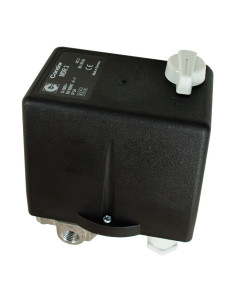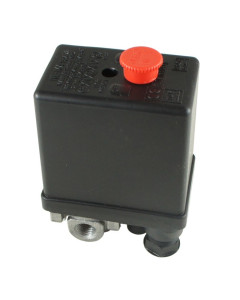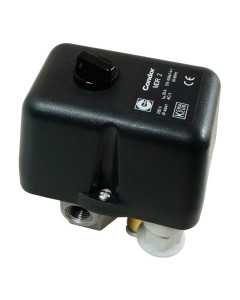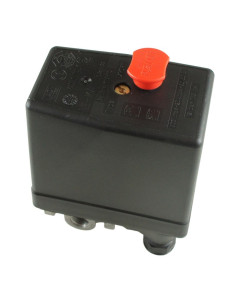-
 Condor MDR 3/11 bar pressure switch - three-phase with thermal protectionEUR 120.23 EUR 97.75
Condor MDR 3/11 bar pressure switch - three-phase with thermal protectionEUR 120.23 EUR 97.75 -
 Condor MDR pressure switch 3/16 bar - three-phase with thermal protectionEUR 122.45 EUR 99.55
Condor MDR pressure switch 3/16 bar - three-phase with thermal protectionEUR 122.45 EUR 99.55
Air Compressor Pressure Switch: Automatic Pressure Control
Pressure switches for air compressors are essential devices in industrial pneumatic systems, specifically designed to automatically control the operation of air compressors. These control components act as switches that regulate the compressor's operating cycle, activating it when system pressure falls below the established lower limit and deactivating it when it reaches the programmed upper limit.
The primary function of a pressure switch is to maintain air pressure within a predetermined range, ensuring both operational efficiency and safety of the entire pneumatic system. By integrating a quality pressure switch into your installation, you ensure optimal performance and significantly extend the service life of your piston compressor or screw compressor.
Technical Characteristics of Compressor Pressure Switches
Pressure switches for air compressors feature various technical characteristics that determine their suitability for specific applications:
- Adjustable pressure range: Typically between 30-175 PSI for standard applications, although high-pressure models can reach up to 580 PSI.
- Pressure differential: The difference between cut-in and cut-out points, adjustable in many models to optimize work cycles.
- Electrical connection: Normally available in single-phase (120V/240V) and three-phase (480V) versions with variable amperage capacities.
- Pneumatic connection: Generally with NPT or BSP threads, in sizes ranging from 1/8" to 1/2".
- Protection: Various IP/NEMA ratings to adapt to different industrial environments, from clean workshops to environments with dust or moisture.
Key Takeaways: Technical Characteristics
- Pressure switches automatically regulate compressor operation within a specific pressure range.
- Proper selection must consider pressure range, connection type, and operating environment.
- Adjustable pressure differential allows optimization of work cycles according to specific needs.
Types of Pressure Switches for Pneumatic Systems
In the market, we find several types of pressure switches for air compressors, each with specific characteristics:
- Conventional mechanical pressure switches: The most common, using a spring and diaphragm system to detect pressure changes and activate an electrical switch.
- Electronic pressure switches: Offer greater precision and reliability, with digital displays for parameter visualization and more precise programming.
- Pressure switches with unloader valve: Incorporate a valve that releases line pressure when the compressor stops, facilitating the next start-up.
- Pressure switches with thermal protection: Include overload protection for the compressor motor, adding an additional layer of safety.
Industrial Applications and Proper Selection
Pressure switches for air compressors are essential components in numerous industrial applications, including:
- Auto repair shops and woodworking facilities where pneumatic tools are used.
- Automated production lines with pneumatic actuators and solenoid valves.
- Spray painting systems that require constant pressure.
- Compressed air installations in hospitals, laboratories, and research centers.
- Pneumatic braking systems in commercial vehicles.
To select the most appropriate pressure switch for your air compressor, consider these key factors:
- Compressor capacity: The pressure switch must be compatible with the size and type of your compressor.
- Required working pressure: Determine the pressure range needed for your specific applications.
- Operating environment: Evaluate the environmental conditions where it will function (temperature, humidity, dust).
- Cycle frequency: For applications with frequent cycles, opt for robust models designed for high durability.
- Safety requirements: Consider if you need additional functions such as thermal protection or unloader valve.
Maintenance and Troubleshooting
Proper maintenance of the pressure switch is essential to ensure optimal operation of the compressed air system. We recommend:
- Periodic visual inspection to detect signs of wear or damage.
- Regular verification of pressure settings to ensure they remain within desired parameters.
- Cleaning of electrical contacts when necessary to prevent failures due to dirt buildup.
- Checking the tightness of pneumatic connections to prevent leaks.
Among the most common problems with pressure switches are:
- Too frequent work cycles, which may indicate an inadequate pressure differential or leaks in the system.
- Compressor start or stop failures, generally related to deteriorated electrical contacts.
- Incorrect pressure readings, which may be due to calibration issues or wear of internal components.
Frequently Asked Questions about Air Compressor Pressure Switches
At Pneumatig, we offer a wide range of pressure switches for air compressors that meet the highest standards of quality and reliability. Our specialists can advise you in selecting the most suitable model for your specific needs, ensuring optimal performance of your pneumatic system.




Login and Registration Form